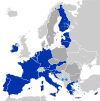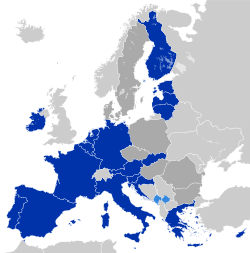Generální ředitelství pro regionální a městskou politiku
| Evropská unie |
 Tento článek je o: |
Politika |
|
Generální ředitelství pro regionální a městskou politiku (DG REGIO[1]) je generálním ředitelstvím Evropské komise.
Generální ředitelství pro regionální a městskou politiku odpovídá za opatření Evropské unie na pomoc hospodářskému a sociálnímu rozvoji znevýhodněných regionů Evropské unie podle článků 158 a 160 Římské smlouvy.
Nástroje - Fondy
- Evropský fond pro regionální rozvoj (ERDF)
- Fondy Evropské unie
- Nástroj pro předvstupní strukturální politiky (ISPA)
- Fond solidarity EU
Odkazy
Reference
V tomto článku byl použit překlad textu z článku Directorate-General for Regional and Urban Policy na anglické Wikipedii.
- ↑ Regionální a městská politika. Evropská komise - European Commission [online]. [cit. 2021-11-05]. Dostupné online.
Související články
Externí odkazy
Média použitá na této stránce
Eurozone
The twelve golden European Union stars.
Autor: JLogan, Licence: CC BY-SA 3.0
Chart of the results of the 2009 European election by the groups in Parliament, intended to replace Image:Composition of the European Parliament.svg.
- In order to allow the chart to be used on all wikis, the chart has no annotations in English.
- The colours follow the convention established on English Wikipedia and are coloured to the following schema:
- For details on English Wikipedia conventions and the groups, see en:Political groups of the European Parliament.
Autor: aJAX, Licence: CC BY-SA 4.0
The legislative triangle of the European Union
Autor: JLogan, Licence: CC BY-SA 3.0
Chart of the results of each European election by their group in Parliament, intended to replace Image:Ep1979-2004.png.
- In order to allow the chart to be used on all wikis, the chart has no annotations in English.
- The chart has no exact percentages on it because exact percentages vary dependent on which source you're looking at: the problems inherent in assembling results from multiple member states, who supply results in different languages at different dates, using different methods, means that even reliable sources differ slightly when compared to each other. To get around this problem, the percentages depicted are based on the agreed average on English Wikipedia.
- The colours follow the convention established on English Wikipedia and are coloured to the following schema:
- For details on English Wikipedia conventions and the groups, see en:Political groups of the European Parliament.
Autor: Ssolbergj; description by Martinvl, Licence: CC BY-SA 4.0
Map showing the extent of theSchengen Agreement.










